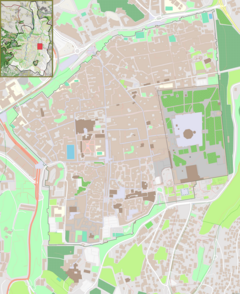| Revision as of 07:27, 30 September 2021 edit85.236.64.188 (talk)No edit summaryTags: Reverted Mobile edit Mobile web edit← Previous edit | Revision as of 07:28, 30 September 2021 edit undoClueBot NG (talk | contribs)Bots, Pending changes reviewers, Rollbackers6,439,660 editsm Reverting possible vandalism by 85.236.64.188 to version by Monkbot. Report False Positive? Thanks, ClueBot NG. (4049723) (Bot)Tag: RollbackNext edit → | ||
| Line 1: | Line 1: | ||
| {{short description|Gate in Jerusalem's Old City Walls}} | {{short description|Gate in Jerusalem's Old City Walls}} | ||
| {{Infobox building | {{Infobox building | ||
| | name = |
| name =Zion Gate | ||
| | native_name = | | native_name = | ||
| | native_name_lang = | | native_name_lang = | ||
| | former_names = | | former_names = | ||
| | alternate_names = | | alternate_names = | ||
| | image =Jerusalem Ziongate BW 4.JPG | | image =Jerusalem Ziongate BW 4.JPG | ||
| | image_alt = | | image_alt = | ||
| | caption = |
| caption = Zion Gate | ||
| | map_type = Old Jerusalem | | map_type = Old Jerusalem | ||
| | map_alt = | | map_alt = | ||
| Line 64: | Line 64: | ||
| | references = | | references = | ||
| }} | }} | ||
| ''' |
'''Zion Gate''' ({{lang-he|שער ציון}}, ''Sha'ar Zion'', {{lang-ar|باب صهيون}}, ''Bab Sahyun'') also known in Arabic as '''Bab Harat al-Yahud''' ("Jewish Quarter Gate"),<ref name="PahlitzschKorn2004">{{cite book|author1=Johannes Pahlitzsch|author2=Lorenz Korn|title=Governing the Holy City: the interaction of social groups in Jerusalem between the Fatimid and the Ottoman period|url=https://books.google.com/books?id=hxgXAQAAIAAJ|access-date=24 May 2011|year=2004|publisher=Reichert|isbn=978-3-89500-404-9|page=122}}</ref> or '''Bab an-Nabi Dawud''' ("Prophet David Gate"), is one of eight ]. | ||
| ==History== | ==History== | ||
| Zion Gate was built in July 1540, west of the location of the medieval gate, which was a direct continuation of the Street of the Jews (also known as the Cardo). Six sentry towers were erected in the southern segment of the wall, four of them situated in the Mount Zion section. |
Zion Gate was built in July 1540, west of the location of the medieval gate, which was a direct continuation of the Street of the Jews (also known as the Cardo). Six sentry towers were erected in the southern segment of the wall, four of them situated in the Mount Zion section. | ||
| In the second half of the nineteenth century, a leper colony, slaughter house and livestock market were situated in the vicinity of Zion Gate. Towards the end of the nineteenth century, shops were built along the length of the southern wall which were torn down during the British Mandate.<ref></ref> | In the second half of the nineteenth century, a leper colony, slaughter house and livestock market were situated in the vicinity of Zion Gate. Towards the end of the nineteenth century, shops were built along the length of the southern wall which were torn down during the British Mandate.<ref></ref> | ||
| Line 74: | Line 74: | ||
| In 2008, restoration work was carried out on the gate, marking its 468th birthday.<ref></ref> | In 2008, restoration work was carried out on the gate, marking its 468th birthday.<ref></ref> | ||
| ] | |||
| <gallery> | <gallery> | ||
| File:James McDonald. City walls, the Zion Gate. 1865 (cropped).jpg|Zion Gate, 1865 | File:James McDonald. City walls, the Zion Gate. 1865 (cropped).jpg|Zion Gate, 1865 | ||
Revision as of 07:28, 30 September 2021
Gate in Jerusalem's Old City Walls| Zion Gate | |
|---|---|
 Zion Gate Zion Gate | |
 | |
| General information | |
| Town or city | Jerusalem |
| Coordinates | 31°46′22.3″N 35°13′45.7″E / 31.772861°N 35.229361°E / 31.772861; 35.229361 |
Zion Gate (Template:Lang-he, Sha'ar Zion, Template:Lang-ar, Bab Sahyun) also known in Arabic as Bab Harat al-Yahud ("Jewish Quarter Gate"), or Bab an-Nabi Dawud ("Prophet David Gate"), is one of eight Gates of the Old City of Jerusalem.
History
Zion Gate was built in July 1540, west of the location of the medieval gate, which was a direct continuation of the Street of the Jews (also known as the Cardo). Six sentry towers were erected in the southern segment of the wall, four of them situated in the Mount Zion section.
In the second half of the nineteenth century, a leper colony, slaughter house and livestock market were situated in the vicinity of Zion Gate. Towards the end of the nineteenth century, shops were built along the length of the southern wall which were torn down during the British Mandate.
On May 13, 1948, as the British Army withdrew from Jerusalem, a major from the Suffolk Regiment presented Mordechai Weingarten with the key for the Zion Gate.
In 2008, restoration work was carried out on the gate, marking its 468th birthday.
See also
References
- Johannes Pahlitzsch; Lorenz Korn (2004). Governing the Holy City: the interaction of social groups in Jerusalem between the Fatimid and the Ottoman period. Reichert. p. 122. ISBN 978-3-89500-404-9. Retrieved 24 May 2011.
- The Conservation of Jerusalem's City Walls
- Joseph, p.69: 'and a sten gun and ammunition'. Collins/Lapierre, p.10: 'a bar of rusted iron about a foot long.'
- This story was repeated by President George W. Bush in his address to the Knesset on the 60-year anniversary of the creation of the State of Israel. 'a short iron bar'
- Preservation project marks 468th birthday of Jerusalem's Zion Gate
31°46′22.3″N 35°13′45.7″E / 31.772861°N 35.229361°E / 31.772861; 35.229361
Categories:


